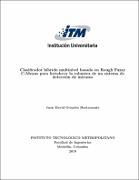| dc.contributor.advisor | Delgado Trejos, Edilson | |
| dc.contributor.author | Grajales Bustamante, Juan David | |
| dc.date.accessioned | 2020-08-27T15:43:03Z | |
| dc.date.available | 2020-08-27T15:43:03Z | |
| dc.date.issued | 2019 | |
| dc.identifier.uri | http://hdl.handle.net/20.500.12622/2091 | |
| dc.description.abstract | Las redes computacionales se han convertido en una parte esencial para las organizaciones, donde el tráfico electrónico se convierte en un soporte vital de las empresas y la inversión en esta área incrementa el potencial de la capacidad de negociación. En este contexto, la ciberseguridad es un desafío dado el panorama de amenazas en constante evolución y toma gran relevancia no sólo en la comunidad científica,sino a nivel empresarial y gubernamental. Una gran variedad de Sistemas de Detección de Intrusos (IDS) basados en Aprendizaje de Máquinas, han jugado un papel importante en la detección de anomalías estructurados en la clasificación .Sinembargo ,estas técnicas siguen siendo débiles en el manejo y modelado de los ataques y amenazas, dada la complejidad de las redes computacionales y el comportamiento no lineal de los ataques, lo cual provoca que sean impredecibles a lo largo del tiempo, generando incertidumbres que constituyen un ensamble interactuante y multivariado. En este contexto se estudiarán los diferentes métodos de detección de intrusos como son: Detección basada en Conocimiento, Detección basada en Métodos Estadíısticos y Detección basada en Aprendizaje de Máquinas, donde se discuten. las técnicas de análisis supervisado, no supervisado y semi supervisado. Por consiguiente se presenta un esquema de clasificación híbrido multinivel, que incluye rutinas Rough Fuzzy c-Means, con el objetivo de lograr robustez en un IDS para cuatro tipos de ataques: Denial of Service (DoS), Probing Attack (PA), Remote to Local (R2L) y User to Root (U2R). Se realizó un proceso de selección de características con los algoritmos Fuzzy Rough Sets (FRS) y Relief F, encontrando que Relief F mejora significativamente la capacidad discriminante del clasificador multinivel. El IDS fue implementado usando la base de datos KDD Cup 99 a través de tres niveles y seis clasificadores. En el nivel uno, el primer clasificador identifica dos clases y una agrupación: DoS, PA y la agrupación compuesta por las clases R2L, U2R y Normal denominada (RUN). El segundo nivelestácompuestoportresclasificadores:losdosprimerosidentificanlasformasdeataque correspondientes a DoS y PA, respectivamente, mientras el tercer clasificador identifica las clases R2L, U2R y Normal. Asimismo, el nivel tres queda compuesto por dos clasificadores que identifican las formas de ataque para R2L y U2R, respectivamente. Se evaluaron tres tipos de clasificadores: Máquinas de Vectores de Soporte (SVM), k- Vecinos más Cercanos (k-NN)yFuzzy c-Means Semi-Supervisado(SSFCM).Se encuentra que SVM ofrece el mejor desempeño en el nivel uno y los dos primeros clasificadores del nivel dos, k-NN en el último clasificador del nivel dos y SSFC M en los clasificadores del nivel tres. Finalmente,se lograron errores inferiores al 1% en los niveles uno y dos, mientras en el nivel tres (clasificación entre las diferentes formas de ataque para R2L y U2R), se obtuvieron errores de alrededor del 7%. De esta manera, con una precisión global del clasificador en los niveles uno y dos de un 99.69%, y para el nivel 3, un resultado del 93% de ataques clasificados como ataques, donde se tomó como función objetivo la robustez del sistema de detección de intrusos | spa |
| dc.format.medium | Recurso electrónico | spa |
| dc.format.mimetype | application/pdf | |
| dc.language.iso | spa | |
| dc.publisher | Instituto Tecnológico Metropolitano | spa |
| dc.subject | Seguridad de tecnología | spa |
| dc.subject | Ciberseguridad | spa |
| dc.subject | Riesgos cibernéticos | spa |
| dc.subject | Procesamiento de datos | spa |
| dc.subject | Medidas de seguridad | spa |
| dc.subject | Protección de datos | spa |
| dc.subject | Seguridad en la red | spa |
| dc.title | Clasificador híbrido multinivel basado en Rough Fuzzy C-Means para fortalecer la robustez de un sistema de detección de intrusos | spa |
| dc.publisher.faculty | Facultad de ingenierías | spa |
| dc.subject.keywords | Product safety | eng |
| dc.subject.keywords | Data protection | eng |
| dc.subject.keywords | Computer security | eng |
| dc.subject.keywords | Computer networks - Security measures | eng |
| dc.subject.lemb | Protección de datos | spa |
| dc.subject.lemb | Seguridad del producto | spa |
| dc.subject.lemb | Seguridad en computadores | spa |
| dc.subject.lemb | Redes de computadores - Medidas de seguridad | spa |
| dc.description.abstractenglish | Computer networks have be come an an essential part of organizations, where electronic trafficis a fundamental support for companies, and investment in this area increases the negotiation capacity. In this context, cybersecurity is a challenge not only for the scientific community but also businesses and government, as threats are in constant evolution. A variety of Intrusion Detection Systems (IDS) based on Machine Learning have played an important role in the detection of structured anomalies in the classification. However, these techniques are still weak in handling and modeling attacks and threats given the complexity of computer networks and the non-line ar behavior of attacks, which causes them to be un predictable over time, generating uncertainties that constitute an interacting and multivariate assembly. In this context, the different methods of intrusion detection will be studied ,suchas: Knowledge based detection, Detection based on Statistics and Detection based on Machine Learning, wheretheyarediscussed.Supervised,un supervised and semi-supervised analysis techniques. Therefore,amulti-level hybrid classification scheme that includes RoughFuzzy c-Meansroutines is presented, with the aim of achieving robustness in an IDS for four types of attacks: Denial of Service (DoS), Probing Attack (PA) , Remote to Local (R2L) and textit User to Root (U2R). A process of feature selection was performed with the Fuzzy Rough Sets (FRS) and Relief F algorithms, finding that Relief F significantly improves the discriminant capacity of the multilevel classifier. The IDS was implemented using the KDD Cup 99 database through three levels and six classifiers. In level one, the first classifier identifies two classes and one grouping: DoS, PA and the grouping composed of classes R2L, U2R and Normal. The second level is composed of three classifiers, the first two identify the attack formscorrespondingtoDoSandPA,respectively,whilethethirdclassifieridentifiestheclasses R2L, U2R and Normal. Likewise, level three is composed of two classifiers that identify the attack forms for R2l and U2R, respectively. Three types of classifiers were evaluated: VectortialSupportMachines(SVM), k-NearestNeighbors(k-NN)andFuzzy c-Means Semi Supervised(SSFCM); finding that SVM offers the best performance in leve lone and the first 2 classifiers of level two, k-NN in the last classifier of level two and SSFCM in classifiers of level three. Finally, errors lower than 1% were obtained in levels 1 and 2, while in level 3 (classification between the different attack forms for R2L and U2R), errors of around 7% could be obtained. In this way, the hybrid multilevel classification scheme was validated, with an overall accuracy of the classifier at level one and two of 99.69% for level 3 with 93% of attacks classified as attacks, taking as objective the robustness of the intrusion detection system | eng |
| dc.identifier.instname | instname:Instituto Tecnológico Metropolitano | spa |
| dc.identifier.reponame | reponame:Repositorio Institucional Instituto Tecnológico Metropolitano | spa |
| dc.identifier.repourl | repourl:https://repositorio.itm.edu.co/ | |
| dc.title.translated | Multilevel Hybrid Classifier Based on Rough Fuzzy C-Means for Enhancing the Robustness of an Intrusion Detection System | eng |
| dc.type.local | Tesis de maestría | spa |
| dc.type.coar | http://purl.org/coar/resource_type/c_bdcc | spa |
| dc.type.driver | info:eu-repo/semantics/masterThesis | spa |
| dc.publisher.grantor | Instituto Tecnológico Metropolitano | spa |


